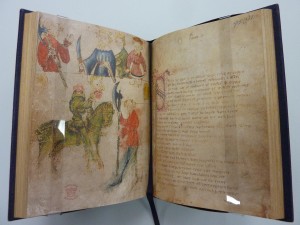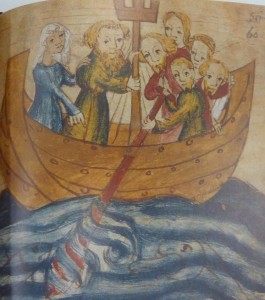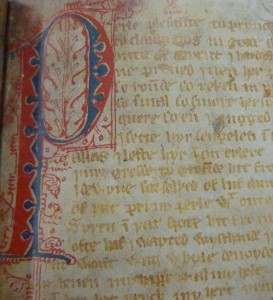A captivating jewel for the Rare Books Collection: The Pearl Manuscript
If you have never imagined being enchanted by a humble book of medieval poetry, a recent acquisition by the Baillieu Library may take you by surprise!
The Library is delighted to announce the purchase of an exquisitely crafted facsimile edition of The Pearl Manuscript, which has been published in a limited print run of 980 copies by the Folio Society, London. [1,2]

What is The Pearl Manuscript?
This comparatively modest quarto-sized manuscript is less than 100 folios (pages) in length and can be easily held in one hand. But the volume’s size and execution belie its importance as the sole extant version of four untitled poems – now known as ‘Pearl’, ‘Cleanness’, ‘Patience’ and ‘Sir Gawain and the Green Knight’ – the first and last of which are considered masterpieces of 14th century literature.
The original vellum manuscript, from which the facsimile has been made, is held by the British Library [3], and is one of the most important source documents for the study of medieval English poetry, contemporary to the works of Geoffrey Chaucer.
Why is it significant?
The Pearl Manuscript is significant in several ways: as well as containing poems and stories composed in a tuneful Middle English, it survives as the only compendium of medieval alliterative verse (in which the same sound is used on many of the stressed words in each line), and is of much interest as a rare example of a lay illustrated manuscript from the period.
An example of alliteration found in ‘Sir Gawain and the Green Knight’ [4]:
Middle English: A feir feld full of folk || fond I þer bitwene…
Modern English: A fair field full of folk || found I there between…

The poems are illustrated with unassuming but charmingly rendered scenes which elucidate selected passages and add much delight to the turning of the page. These include an energetic group of medieval paddlers on Noah’s Ark (Cleanness) and an ardent dreamer and his heavenly pearl adorned maiden separated by a billowing stream (The Pearl).
Origins and authorship
Adding to the intrigue of The Pearl Manuscript, are several questions surrounding its provenance and authorship. The dialect used by poet and scribe has been localised to the north-west Midlands of England (possibly the Cheshire, Staffordshire, Lancashire or Derbyshire borders), and from internal clues the poems appear to have been written in the period 1360-1380.

The exact attribution of the poems remains unknown, and the name of ‘the Gawain-Poet’ or ‘the Pearl-Poet’ as he has become known, has been the topic of scholarly debate. At one time the author was thought to be Hugh Massey, a member of a landed Cheshire family and local cultured elite. Recent scholarship has shown that there were only a small number of estates in late 14th century Cheshire, and it is more likely that the poet was a minor cleric working in London for a west Midlands noble, close to Richard II’s court (1377-1399).
A fascinating survival
The survival of The Pearl Manuscript is in itself an intriguing tale. The first traceable owner was Yorkshire collector Henry Savile (1568-1617), who procured the volume sometime after the great abbeys and monasteries of northern England were dissolved and their assets appropriated and dispersed in the mid-16th century.
After Savile’s death the manuscript made its way into the possession of the famous book collector, Sir Robert Cotton (1570/1-1631). The volume was listed by Cotton’s librarian but it appears that he did not read much beyond the first folio and realise that the manuscript contained four separate texts. Then, most fortuitously, the manuscript survived the devastating fire of Cotton’s Library in 1731 in which many important medieval works were lost.
Incredibly, despite the manuscript’s medieval origins, all four poems remained obscure until 1839 when ‘Sir Gawain and the Green Knight’ was first edited by Sir Frederic Madden in a published collection of Gawain romances. [5] Since then all four poems have risen in popularity and attracted detailed scholarly attention, including by J.R.R. Tolkein who co-edited a translation in 1925.[6]
Interested in learning more?
• An engaging introduction to The Pearl Manuscript can be found in Malcolm Andrew’s and Ronald Waldron’s The Poems of the Pearl Manuscript. 5th edition. Exeter: University of Exeter Press, 2007.
• A digitised version of The Pearl Manuscript can be accessed at http://contentdm.ucalgary.ca/cdm/landingpage/collection/gawain
• You can read a modern translation of the ‘The Pearl’ online at http://www.gutenberg.org/files/13211/13211-8.txt
• Watch a documentary of ‘Sir Gawain and the Green Knight’ including excerpts read in Middle English at https://www.youtube.com/watch?v=-nAd6fffVvs
• ‘Sir Gawain and the Green Knight’ is the first lecture in the Faculty of Arts 10 Great Books 2016 series.

Susan Thomas (Rare Books Curator)
[1] The Pearl Manuscript. London: Folio Society, 2015.
[2] The Folio Society was established in London in 1947 for the purpose of publishing faithfully rendered facsimiles of the classics of world literature. Your can discover more than 140 other Folio Society editions in the Rare Books Collection in the University Library catalogue.
[3] London, The British Library, MS Cotton Nero A.x.
[4] ‘Alliterative verse’, Wikipedia: the free encyclopedia, viewed 22 February 2016 https://en.wikipedia.org/wiki/Alliterative_verse
[5] Madden, F. Syr Gawayne: a collection of ancient romance-poems by Scotish [sic] and English authors. London: Bannatyne Club, 1839.
[6] Tolkein, J.R.R. & E.V. Gordon (eds). Sir Gawain and the Green Knight. Oxford: Clarendon Press, 1925.
Leave a Reply